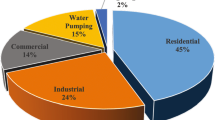Abstract
A statistical analysis was performed of the electrical load curve according to which the Novocherkassk District Power Plant (NсhGRES) operated in the period between 2009 and 2018. The effect of weather and climatic factors, such as daylight time, ambient air temperature, and wind strength, on the electrical load was examined. Climatic components of the NсhGRES electric load were estimated, and it has been demonstrated that the additional lighting load depending on the daylight time in Rostov oblast was as great as 35.4%, the seasonal heating load was up to 11.3%, and the seasonal cooling load was up to 20.2% of the normal baseload. It is shown that the basic heating load in Rostov oblast is carried by centralized and individual heat supply systems, and electric heating appliances are activated when the centralized heat supply systems cannot cover the heating load due to poor maneuverability. The heating component of the electric load depends not only on the ambient air temperature but also on the wind velocity. A formula was derived using the fuzzy logic technique for calculating heat consumption in a heating system depending on ambient air temperature and wind speed. It is noted that high wind speed aggravates the negative temperature factor, bringing about the need to turn on additional heating appliances and, thereby, increasing the electrical load. A fundamental change in the shape of the annual electric load curve within the studied period was revealed: the appearance of the summer maximum load whose amplitude in terms of the indicators approached the winter one and even exceeded it in certain years, which can be attributed to the climate change in the region of the power plant site and the advent of a new type of electrical equipment, i.e., climatic control cooling units. The maximum monthly power consumption of cooling units is 1.8 times the maximum monthly power consumption of heating units and 1.7 times less than the maximum additional monthly power consumption of lighting facilities. The maximum power consumption for each type of equipment occurs in different months of the year. This change is a stable trend that should be considered, in particular, in scheduling maintenance activities at the power plant.













Similar content being viewed by others

REFERENCES
V. Ya. Ryzhkin, Thermal Power Plants: Textbook, Ed. by V. Ya. Girshfel’d, 3rd ed. (Energoatomizdat, Moscow, 1987) [in Russian].
L. S. Sterman, V. M. Lavygin, and S. G. Tishin, Thermal and Nuclear Power Plants (Mosk. Energ. Inst., Moscow, 2010) [in Russian].
RD 34.20.501-95. Rules of Technical Operation of Power Plants and Grids of the Russian Federation (SPO ORGRES, Moscow, 1996).
Novocherkassk State District Power Plant. https:// www.ogk2.ru/rus/branch/novocherkgres/
Rostov-on-Don. https://ru.wikipedia.org/wiki/Pocтoв-нa-Дoнy
Federal State Statistics Service. Official Website. https://www.gks.ru/
Energy Saving for the People! Enargys.ru. http://enargys.ru/
GOST R 50779.10-2000. Statistical Methods. Probability and General Statistical Terms. Terms and Definitions, Approved and Enacted by Gosstandart Rossii Decree No. 429-st of December 29, 2000.
Climate Data of Cities Worldwide. https://en.climate-data.org
Weather — Meteoservis.ru. https://www.meteoservice.ru/
Gismeteo. https://www.gismeteo.ru/
Sunrise. https://voshod-solnca.ru/sun
GOST 30494-2011. Residential and Public Buildings. Microclimate Parameters for Indoor Enclosures (2013).
SP 131.13330.2012. Building Climatology. Updated Edition of SNiP 23-01-99* (with Changes No. 1, 2) (2013).
V. S. Falikov, Energy Saving in Heat and Water Supply Systems of Buildings (GUP VIMI, Moscow, 2001) [in Russian].
D. V. Drozd, Yu. V. Elistratova, and A. S. Seminenko, “The effect of wind on indoor microclimate: A report at the international online student scientific conference ‘Student Scientific Forum 2013’,” Sovrem. Naukoemkie Tekhnol., No. 8–1, 37–39 (2013).
L. A. Zadeh, The Concept of a Linguistic Variable and its Application to Making Approximate Decisions (National Technical Information Service, Springfield, Va., 1973; Mir, Moscow, 1976).
N. V. Fedorova, D. A. Shaforost, and V. R. Bundikova, “Modeling the heating system operation modes with fuzzy logic methods application,” in Theory and Practice of Transdisciplinary Research in the Modern World (Proc. Int. Sci.-Pract. Conf., St. Petersburg, Aug. 1–2, 2019) (S.-Peterb. Gos. Ekon. Inst., St. Petersburg, 2019), pp. 83–87. https://elibrary.ru/download/elibrary_ 39455372_21623208.pdf
N. V. Fedorova, V. R. Bundikova, A. M. Kolomiitseva, Yu. V. Shcheglov, and Yu. V. Fedorov, “Modeling of heat consumption in housing and communal services with fuzzy logic methods,” in Ecological, Industrial and Energy Safety — 2019 (Proc. Sci.-Pract. Conf., Sevastopol, Sept. 23–26, 2019) (Sevastop. Gos. Univ., Sevastopol, 2019), pp. 1664–1668. https://elibrary.ru/download/ elibrary_42886403_60446145.pdf
Author information
Authors and Affiliations
Corresponding author
Additional information
Translated by T. Krasnochcshekova
Rights and permissions
About this article
Cite this article
Fedorova, N.V. The Effect of Climatic Factors on the Electric Load of Thermal Power Plants (TPP) in the Southern Federal District by the Example of the Novocherkassk District Power Plant (GRES). Therm. Eng. 68, 324–335 (2021). https://doi.org/10.1134/S0040601521030034
Received:
Revised:
Accepted:
Published:
Issue Date:
DOI: https://doi.org/10.1134/S0040601521030034



